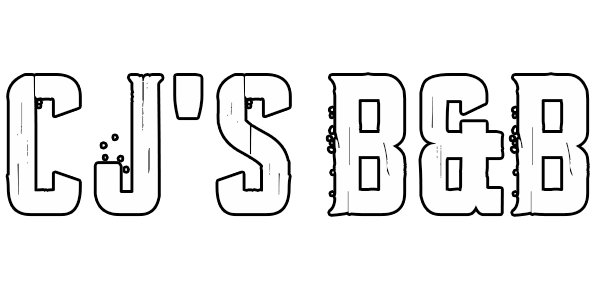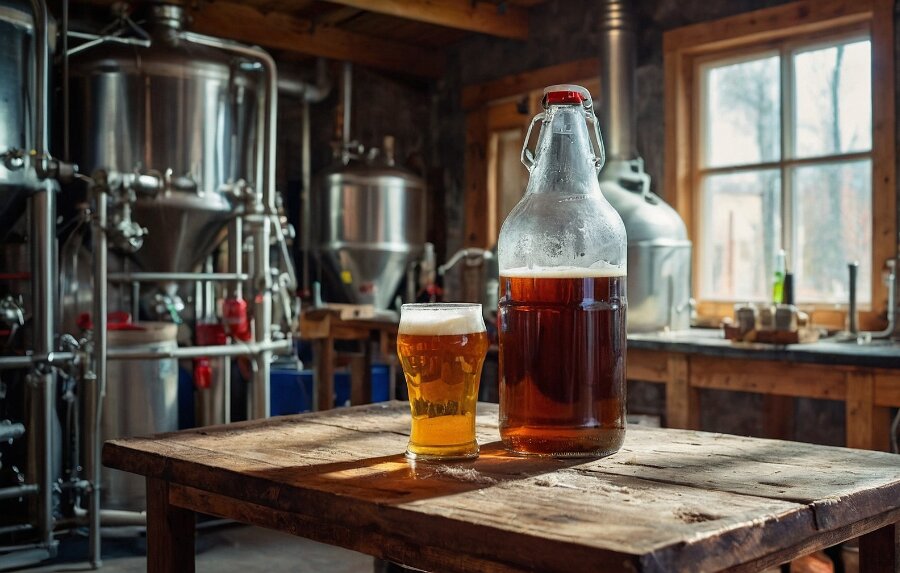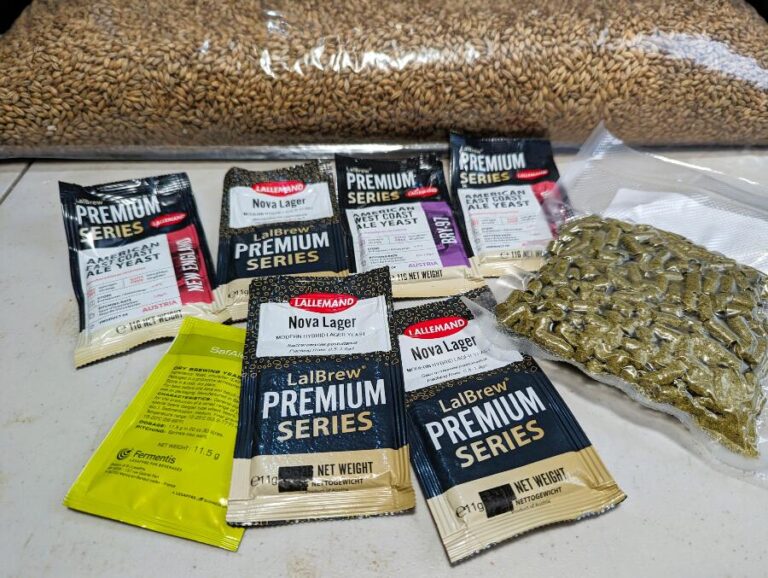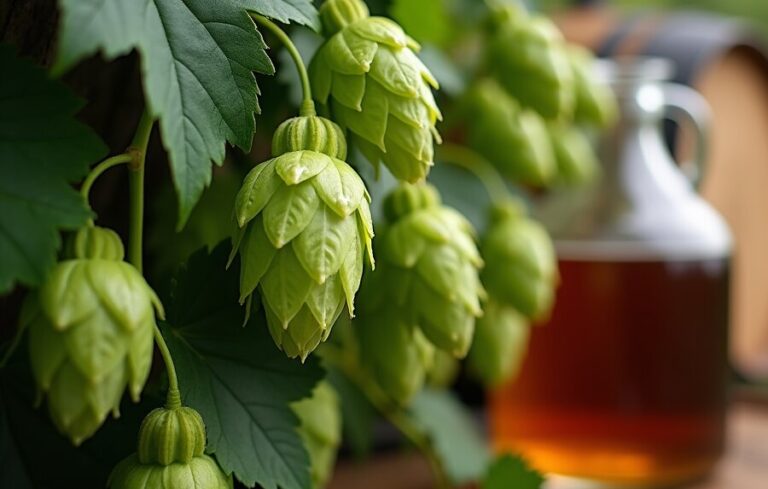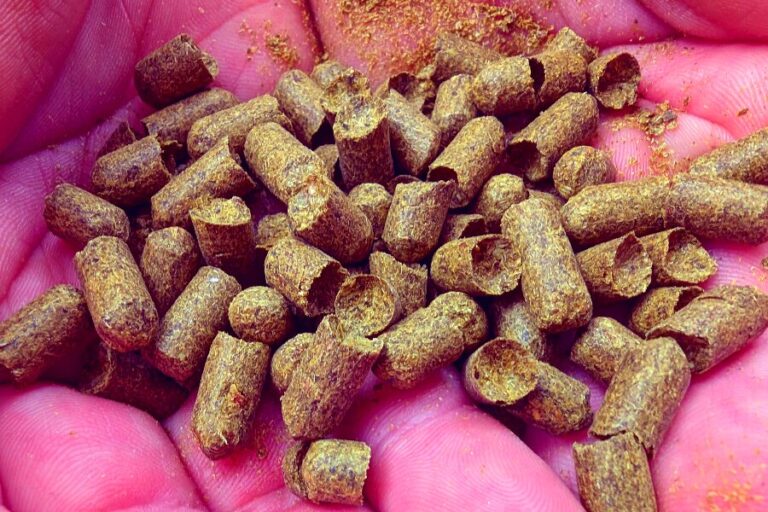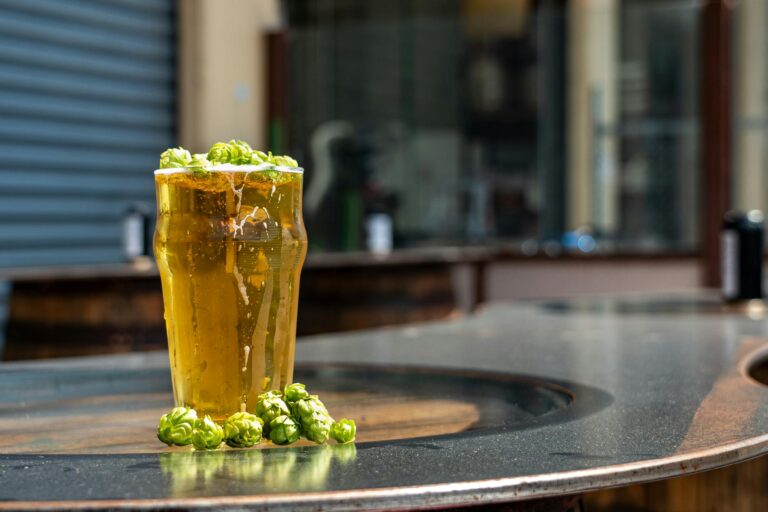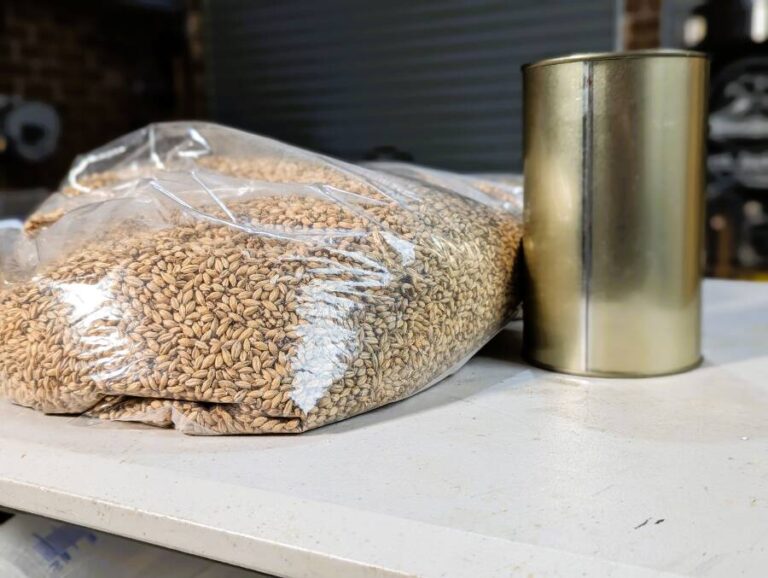Our evaluations and product assessments are conducted using a thorough and unbiased approach. Should you choose to buy any items through our provided links, we might receive a commission Read our disclosures.
Are you ready to embark on a flavourful journey into the world of homebrewing? Crafting your own beer isn’t just a hobby – it’s an art form that’s exploding in popularity! Whether you’re a curious beginner or a seasoned brewer looking to refine your skills, our ultimate guide to making a homebrew beer recipe will help you create that perfect pint right in your own kitchen. Get ready to impress your friends and tantalize your taste buds with your very own liquid gold!
Essential Ingredients for Your Homebrew Beer Recipe
- Water is the unsung hero of homebrewing, forming the foundation of every great beer. It makes up about 90-95% of your brew, so its quality and composition are crucial. The mineral content of your water can significantly influence the flavour, mouthfeel, and overall character of your beer. For instance, calcium enhances yeast health and clarity, while bicarbonates can affect the pH balance, impacting the bitterness and malt profile. Whether you’re using tap, filtered, or bottled water, understanding its properties and making necessary adjustments can elevate your homebrew from good to exceptional. So, before you start brewing, take the time to analyze and optimize your water to craft the perfect pint.
- Malted grains are the backbone of beer, providing essential sugars for fermentation and significantly influencing flavour, color, and aroma. Barley is the most common, with 2-row offering a clean, sweet flavour and 6-row providing higher enzyme content. Other grains like wheat, rye, and oats add unique characteristics: wheat enhances head retention and smoothness, rye adds a spicy note, and oats contribute a creamy mouthfeel. Specialty malts, such as chocolate and crystal malts, introduce complex flavours from roasted coffee to caramel sweetness. By selecting and combining different malts, brewers can create a wide range of beer styles and flavours.
- Hops add bitterness and aroma to beer, balancing the malt’s sweetness. Bittering hops like Chinook provide bitterness, while aroma hops like Saaz offer floral or citrusy notes. Dual-purpose hops, such as Cascade, contribute both. Early hop additions increase bitterness, while late additions and dry hopping enhance aroma. Experimenting with different hops and timings allows brewers to create diverse flavours and aromas.
- Yeast is the engine of fermentation, converting sugars into alcohol and carbon dioxide while producing a range of flavours and aromas. Different yeast strains, such as Saccharomyces cerevisiae and Saccharomyces pastorianus, can significantly influence the final taste of your beer. Ale yeasts typically ferment at warmer temperatures, producing fruity and spicy notes, while lager yeasts work at cooler temperatures, resulting in cleaner, crisper flavours1. The choice of yeast strain can also affect the beer’s mouthfeel and clarity, making it a crucial element in crafting your perfect pint.
Choosing Your Homebrew Beer Recipe Style
- Popular beer styles include American Pale Ale, known for its balanced malt and hop profile with citrusy notes, and Dry Irish Stout, which features a rich, roasted flavour with a dry finish. Hefeweizen is another favorite, offering a refreshing, fruity, and slightly spicy taste due to its wheat base and unique yeast strains1. For those who enjoy a bit of complexity, Belgian Saison provides a blend of fruity, spicy, and earthy flavours. These styles are not only enjoyable to brew but also offer a great introduction to the diverse world of homebrewing.
- Factors to consider when selecting a beer style for homebrewing, consider factors like your personal taste preferences, the complexity of the brewing process, and the availability of ingredients. Think about the season and occasion—lighter beers like Hefeweizens are great for summer, while richer styles like Stouts are perfect for colder months. Also, consider the fermentation time and equipment you have; some styles require specific temperatures or longer aging periods. By aligning your choice with these factors, you can ensure a more enjoyable and successful brewing experience.
- Adapting a homebrew beer recipe to your taste preferences is a rewarding aspect of homebrewing. Start by tweaking the malt bill to adjust sweetness or body, and experiment with different hop varieties to find your ideal balance of bitterness and aroma. You can also play with yeast strains to influence the flavour profile, from fruity and spicy to clean and crisp. Don’t be afraid to add unique ingredients like spices, fruits, or herbs to create a signature brew. By making these adjustments, you can craft a beer that perfectly matches your personal taste.
- Finding a reliable homebrew beer recipe is easier than ever with a wealth of resources available. Online forums like Homebrew Talk and Brewer’s Friend offer community-tested recipes and valuable brewing advice. Websites such as BeerSmith and Brew Your Own provide detailed recipes and brewing tips from experts. Additionally, books like “The Complete Joy of Homebrewing” by Charlie Papazian and “How to Brew” by John Palmer are excellent references for both beginners and experienced brewers. These resources can help you discover tried-and-true recipes and inspire your own brewing adventures.
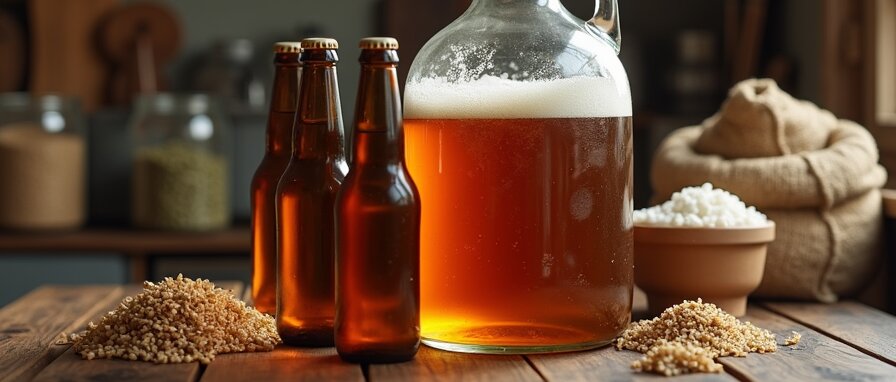
Step-by-Step Homebrew Beer Recipe Process
- Sanitization is crucial in homebrewing, as it prevents unwanted bacteria and wild yeast from contaminating your beer. Even a small lapse in cleanliness can lead to off-flavours or spoilage. Before brewing, thoroughly clean and sanitize all equipment, including fermenters, bottles, and utensils. Use a no-rinse sanitizer like Star San to ensure everything is properly sanitized without leaving any residue. By maintaining strict sanitization practices, you can ensure the quality and consistency of your brew, leading to a successful and enjoyable homebrewing experience.
- Mashing is a crucial step in homebrewing where malted grains are mixed with hot water to extract fermentable sugars. This process activates enzymes in the grains, breaking down starches into simpler sugars that yeast can later ferment into alcohol. The temperature and duration of the mash can influence the beer’s body and sweetness. Typically, mashing occurs between 65-70°C (149-158°F) for about an hour. By carefully controlling these variables, brewers can optimize sugar extraction and create a balanced, flavourful wort ready for fermentation.
- Boiling is a vital step in homebrewing where the wort is sterilized, and hops are added to impart bitterness, flavour, and aroma. Typically lasting 60-90 minutes, the boil helps extract alpha acids from the hops, which balance the sweetness of the malt. Early hop additions contribute bitterness, while later additions enhance flavour and aroma. The boiling process also helps to concentrate the wort and remove unwanted compounds, ensuring a clean, stable beer. By carefully timing hop additions, brewers can craft a well-balanced and flavourful brew.
- Cooling and fermentation are critical steps that bring your beer to life. After boiling, the wort must be rapidly cooled to a temperature suitable for yeast pitching, typically around 20°C (68°F). This quick cooling helps prevent contamination and preserves the wort’s quality. Once cooled, yeast is added to start fermentation, where it converts sugars into alcohol and carbon dioxide, creating the beer’s flavour and carbonation. Maintaining a consistent fermentation temperature is key to achieving the desired taste and aroma. By carefully managing these steps, you ensure a successful fermentation process and a delicious final product.
- Bottling or kegging is the final step in homebrewing, where your beer is packaged for carbonation and storage. Bottling involves adding a small amount of priming sugar to each bottle before sealing, allowing the yeast to produce natural carbonation over a couple of weeks. Kegging, on the other hand, uses a CO2 tank to carbonate the beer more quickly and allows for easier dispensing. Both methods have their advantages: bottling is cost-effective and portable, while kegging offers convenience and control over carbonation levels. By choosing the right packaging method, you can ensure your beer is ready to enjoy at its best.
Equipment Needed for Homebrewing
- Essential tools for beginners: Starting your homebrewing journey requires a few essential tools to ensure success. You’ll need a brew kettle for boiling your wort, a fermenter with an airlock to allow fermentation gases to escape, and a hydrometer to measure the specific gravity of your brew. A thermometer is crucial for monitoring temperatures during mashing and fermentation. Additionally, a sanitizer like Star San is vital for keeping your equipment clean and free from contaminants. With these basic tools, you’ll be well-equipped to start brewing your own delicious beer at home.
- Advanced equipment for serious homebrewers: For serious homebrewers looking to elevate their craft, investing in advanced equipment can make a significant difference All-in-one electric brewing systems like the Grainfather or Brewzilla streamline the brewing process by combining the mash tun and kettle, reducing space and simplifying temperature control1. Stainless steel conical fermenters offer superior durability and ease of use, allowing for precise control over fermentation and easy sampling2. Additionally, temperature controllers paired with chest freezers or fermentation chambers ensure consistent fermentation temperatures, crucial for producing high-quality beer3. These upgrades not only enhance the brewing experience but also improve the consistency and quality of your homebrew.
- DIY options for budget-conscious brewers: For budget-conscious brewers, DIY options can be a great way to save money while still producing quality beer. Consider building your own mash tun using a cooler and some basic plumbing supplies, which can be more cost-effective than purchasing a pre-made one. Repurposing household items, like using a large pot for boiling wort or converting a fridge into a fermentation chamber, can also cut costs. Additionally, sourcing ingredients in bulk and reusing yeast from previous batches can help stretch your budget further. With a bit of creativity and resourcefulness, you can enjoy homebrewing without breaking the bank.
- Proper cleaning and maintenance are essential for successful homebrewing. Always clean your equipment immediately after use to prevent residue buildup and potential contamination. Use a dedicated brewing cleaner like PBW (Powdered Brewery Wash) to remove stubborn residues, and follow up with a no-rinse sanitizer like Star San to ensure everything is sanitized before your next brew. Regularly inspect and replace any worn-out parts, such as gaskets and tubing, to maintain a tight seal and prevent leaks. By keeping your equipment clean and well-maintained, you can ensure the quality and consistency of your homebrew.
Troubleshooting Common Homebrew Beer Issues
- Off-flavours in homebrew can be disappointing, but identifying and preventing them is key to improving your beer. Common off-flavours include acetaldehyde, which tastes like green apples and is often due to incomplete fermentation, and diacetyl, which imparts a buttery flavour and can result from bacterial contamination or rushed fermentation. Phenolic flavours, reminiscent of medicinal or smoky notes, are usually caused by wild yeast or improper sanitization. To prevent these issues, ensure thorough cleaning and sanitization, maintain proper fermentation temperatures, and allow sufficient time for fermentation and conditioning. By addressing these factors, you can minimize off-flavours and produce a cleaner, more enjoyable beer.
- Fermentation problems can arise from various factors, but understanding their causes and solutions can help you troubleshoot effectively Stuck fermentation, where yeast activity halts prematurely, is often due to inadequate yeast health, incorrect temperatures, or lack of nutrients. Ensuring proper yeast pitching rates, maintaining optimal fermentation temperatures, and adding yeast nutrients can resolve this issue1. Off-flavours like acetaldehyde (green apple taste) or diacetyl (buttery flavour) typically result from incomplete fermentation or poor sanitization. To prevent these, ensure thorough cleaning, proper fermentation time, and temperature control2. By addressing these common issues, you can improve the quality and consistency of your homebrew.
- Achieving crystal-clear beer is a common goal for homebrewers, and several techniques can help. Cold crashing, which involves rapidly cooling the beer after fermentation, encourages suspended particles to settle out. Using fining agents like gelatin or isinglass can also help clarify the beer by binding to haze-causing proteins and yeast, making them easier to remove. Additionally, proper filtration and allowing sufficient time for conditioning can further enhance clarity. By implementing these methods, you can produce a visually appealing beer with a polished, professional look.
- Carbonation challenges: Achieving the perfect carbonation in your homebrew can be challenging but is essential for a satisfying drinking experience. Under-carbonation can result from insufficient priming sugar or poor yeast health, while over-carbonation might be due to excessive priming sugar or bottling too early. To get it just right, carefully measure your priming sugar based on the beer style and desired carbonation level. Ensure your yeast is healthy and active, and always verify that fermentation is complete before bottling. By paying attention to these details, you can achieve the ideal fizz and enhance the overall quality of your beer.
Scaling and Adjusting Your Homebrew Beer Recipe
- Understanding brewing calculations is essential for creating consistent and high-quality beer. Key calculations include original gravity (OG) and final gravity (FG), which help determine the alcohol content and sweetness of your beer. Bitterness units (IBUs) measure the bitterness contributed by hops, while color units (SRM) indicate the beer’s color. Calculating the efficiency of your mash process ensures you’re extracting the maximum fermentable sugars from your grains. By mastering these calculations, you can fine-tune your recipes and achieve your desired beer characteristics with precision.
- Software tools can help homebrewers formulate and refine their recipes with precision. Programs like BeerSmith and Brewfather offer comprehensive features, including ingredient databases, brewing calculators, and step-by-step guides. These tools allow you to adjust variables like malt, hops, and yeast to see how changes affect the final product. Additionally, they provide valuable insights into metrics such as original gravity, bitterness (IBUs), and color (SRM). By leveraging these tools, you can experiment with different recipes and achieve consistent, high-quality results in your homebrewing endeavors.
- Experimenting with ingredients and ratios is one of the most exciting aspects of homebrewing. By adjusting the proportions of malt, hops, and yeast, you can create unique flavour profiles and discover new beer styles. Try incorporating different grains like rye or oats to add complexity, or experiment with various hop varieties to find your perfect balance of bitterness and aroma. You can also play with yeast strains and fermentation temperatures to influence the final taste. This creative process allows you to tailor each brew to your personal preferences and continually refine your recipes.
- Keeping detailed brewing records is essential for improving your homebrewing skills and achieving consistent results. Documenting each step of the process, from ingredient measurements and mash temperatures to fermentation times and tasting notes, allows you to track what works and what doesn’t. This information helps you replicate successful batches and make informed adjustments to future recipes. Additionally, noting any deviations or issues encountered can aid in troubleshooting and refining your techniques. By maintaining thorough records, you can continually enhance your brewing process and craft better beer with each batch.
Congratulations! You’re now armed with the knowledge to create your very own homebrew beer recipe. Remember, homebrewing is a blend of science and art – don’t be afraid to experiment and make each batch your own. As you refine your skills, you’ll discover the joy of sharing your unique creations with friends and fellow beer enthusiasts. So, what are you waiting for? Grab your brewing kettle, roll up your sleeves, and let’s get brewing! Who knows? Your next batch might just be award-winning material. Cheers to your homebrewing adventure!

